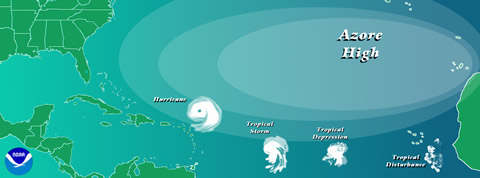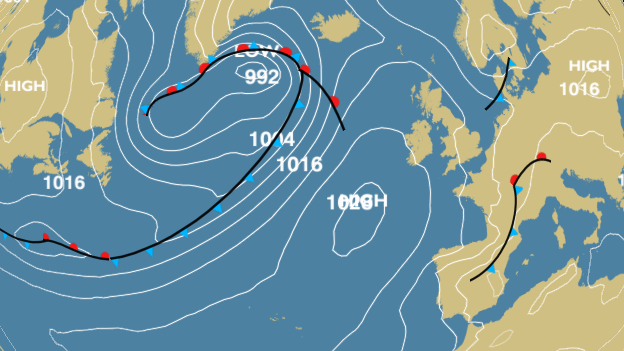Azores High
The Azores High is an effective as an action center area of high pressure that develops in the area of the Azores in the North Atlantic and plays a crucial role for the weather in Central Europe.
Formation
The Azores High is part of the subtropical high pressure belt of the North Atlantic and occurs at the edge of a vertebra of the polar front jet stream -. In general form for Europe Azores high and Iceland low the vital role of the weather situations: in general, driven by the general westerlies in the northern hemisphere low pressure systems ( cyclones ) come on mid-latitudes of the North American coast of the Atlantic Ocean ( Atlantic West weather). Depending on the nature of the two systems ( expansion and pressure difference ) the low-pressure systems to the south or the north are shifted, so that the individual parts of Europe are taken from the center of the warm front or cold front.
Here, the Azores High migrates in the seasonal rhythm. In the long-term average (1881-1995), the Azores High downtown in the winter is 33 ° N, in the summer at 34.5 ° N, the middle layer varies from the Azores in 1400 nautical miles to the northeast and about 1500 nautical miles to the southwest, where extreme positions before Ireland, Newfoundland and the Canaries were measured up to the west coast of Africa, either in the summer, and winter. The average air pressure is 1025 hPa, with variations in the monthly mean 1034-1016 hPa
At times, the Azores High is expanding in the form of a wedge out to Central Europe; when replacing a high pressure cell, it can pull up to Scandinavia. Connects the wedge with a continental high (about Russia ), one also speaks of Omega High ( after the Ω -shaped, far northward expansion between two centers) - such a highly stable situation has led some to the heat wave of 2003, the more than two weeks in August led to temperatures of 40 ° C in Central Europe.
Impact during the year
Are the winter Iceland low and the Azores high and pronounced There is, therefore, a large difference in air pressure, the result is a mild west wind situation, the winter is rather moist. At a low pressure difference, however, the cold, dry air over Eastern Europe (Russia high ) determined the winter weather in Central Europe.
In spring, when the sun rises in its zenith and the Azores High migrates to the north, is increased air which has been heated by the Gulf Stream, transported to Europe. Around this time, the weather is typically unstable ( Spätwinterliche, often strong snowfall events, late winter storms and winter storms up to the April weather, with rapid construction of the Azores high and premature heat waves )
Even in summer, determine Iceland low and the Azores high, if a rainy, changeable or stable summer reigns. In common interpretations corresponds to the " Seven Sleepers " rule (the weather on / around the Seven Sleepers holds 40 days ) of the meteorological question of where and how powerful the Azores high pressure has built up after the summer solstice.
Early autumn often prevail only small differences in air pressure when the temperatures are equalized by sea and land masses: It turns a quiet weather conditions a ( Indian summer ), upon further cooling, the West Weather meeting unhindered (autumn hurricanes ) until the winter Azores high pressure has stabilized.
- Examples of the impact of the Azores high
And location of the ... Azoren-/Bermudahochs control the migration routes of hurricanes
A Azores High ( Biskayalage ) and a low over the Baltic states lead to a collapse of polar cold air in the Mediterranean: Mistral
The North Atlantic Oscillation
In perennial cycles ( approximately every 7 years) with large differences in pressure between the Azores high and Iceland low superseded by winters with little difference winter weather conditions. This phenomenon is the North Atlantic Oscillation ( NAO) called, which was described by Walker for the first time in 1923. An international team led by Thomas Felis and Gerrit Lohmann from the DFG Research Center Ocean Margins, University of Bremen has demonstrated by studies of coral that this Klimaduo has the weather in Central Europe and the Middle East already determined during the last interglacial period 122,000 years ago. It is believed today that the cycles of El Niño events affect those of the NAO.
Media
- Azores high and Iceland low. Series universe. Kurt Mayer (Book ), Dieter Pochlatko (Producer), Andrew Hunter ( Chair ), Kurt Adametz ( music); ORF, O.D. ( shop.orf.at )










